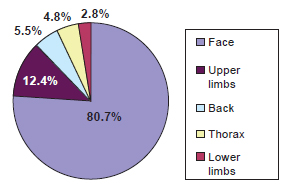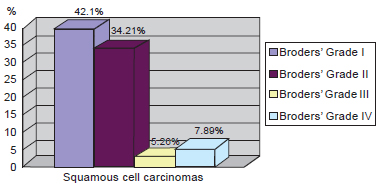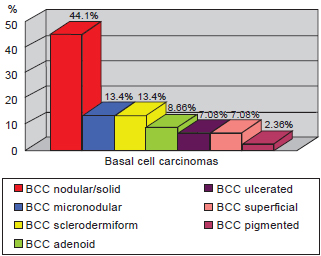ABSTRACT
BACKGROUND: A higher incidence and prevalence of non-melanoma skin cancers has been reported in Brazil. Among them, basal cell carcinoma (BCC) is the most common, accounting for 70%-75% of all cases. Squamous cell carcinoma (SCC) constitutes 20% of non-melanoma skin cancers. The aim of this study was to examine the patients who underwent surgery for the treatment of non-melanoma skin cancer between 2005 and 2010 at the Plastic Surgery Service of Hospital Ipiranga.
METHODS: The medical records of the patients who were treated for non-melanoma skin cancer at the surgical center were reviewed and classified according to age, gender, occupation, race, anatomical location, risk factors, number of lesions, and histological subtype.
RESULTS: A total of 145 patients were evaluated; 15.9% exhibited multiple lesions, which resulted in a total of 168 tumors. BCC was most commonly detected (87.6% of the tumors), whereas 26.2% of tumors were SCC. Solid or nodular BCC comprised 44.1% of all skin cancers, whereas Broders I SCC accounted for 42.1% of SCC cases. The lesions were present on the face in 80.7% of the patients and on the upper limbs in 12.4%. The average patient age was 69.5 years, and 59.4% of the patients were female. The tumors were more commonly observed in Caucasians, and smoking was the major risk factor recorded in 79.3% of cases.
CONCLUSIONS: The patients with cancer in this study tended to have BCC and/or were predominantly female - observations that reflect the current tendency of this tumor. The presence of a significant number of patients with multiple lesions emphasizes the importance of undergoing a periodic examination. Moreover, high smoking rates were observed among these patients.
Keywords: Basal cell carcinoma. Squamous cell carcinoma. Carcinoma/surgery.










